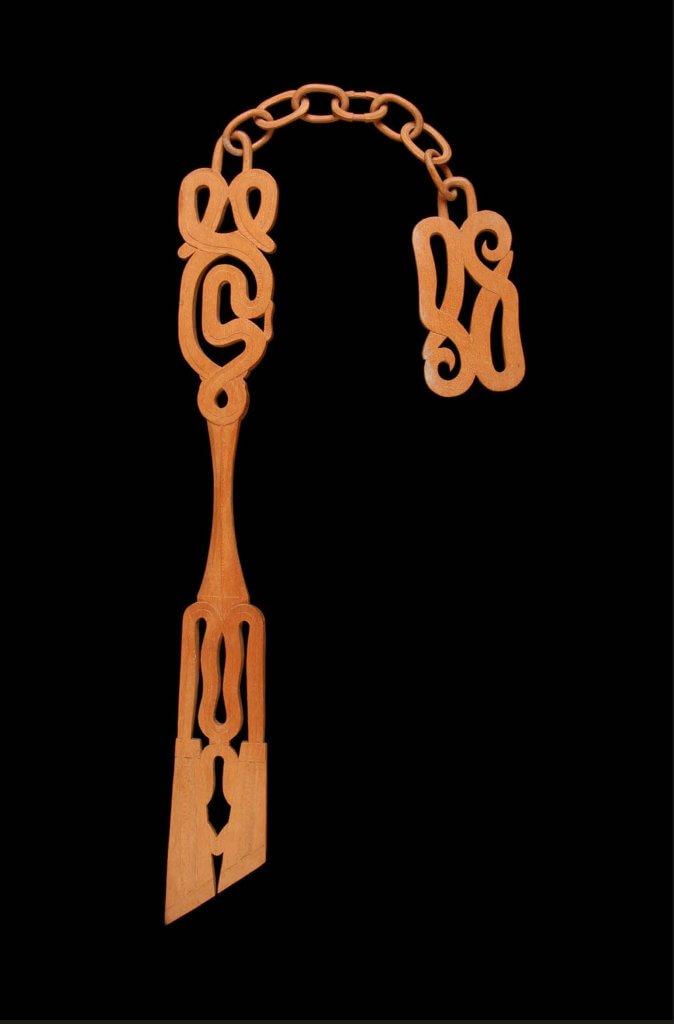Suriname in Paris

Marcel Pinas
Marronage – The art of breaking your chains
Objects and photographs from the collections of the musée du quai Branly – Jacques Chirac; Art (tembe), contemporary painting and photography, textiles. Iconography.
Curators: Geneviève Wiels and Thomas Mouzard.
Artists and photographers presented: Sherley Abakamofou, Carlos Adaoudé, Franky Amete, Wani Amoedang, Antoine Dinguiou, Karl Joseph, Antoine Lamoraille, John Lie A Fo, Nicola Lo Calzo, Feno Montoe, Ramon Ngwete, Gerno Odang, Marcel Pinas, Pierre Verger.
The exhibition “Marronnage, l’art de briser ses chaînes” (Marrying, the art of breaking one’s chains) is proposed by the Maison de l’Amérique latine and is based on an idea by Hervé Télémaque.

It is accompanied by a book published in co-edition with Éditions Loco, with a preface by Christiane Taubira, and by a series of conferences and documentary film screenings to highlight the history and plastic productions of peoples of African origin who were forcibly transported to South America and who structured themselves into societies that emerged from the flight and the refusal of slavery. See dates: Wednesday, May 18 and Tuesday, May 24, Tuesday, June 14 and Wednesday, June 15.
Excerpt from the catalog by Geneviève Wiels and Thomas Mouzard :
In Suriname and French Guiana, where the forest protected them, these societies (the Saamaka, Dyuka, Paamaka, Boni-Aluku, Matawai and Kwinti) first had to defend their freedom, then build, develop and peace returned to express their sense of beauty, of grace: the mean.
Our ambition is to show and contextualize the continuity and artistic creativity expressed by these peoples, by presenting objects produced in the first half of the twentieth century, which have become museum collections, and an overview of current creations. For contrary to what some ethnologists may have thought in the 1930s, when they were collecting not works of art but pieces of “evidence” – study pieces of peoples on the verge of extinction – the Maroons have continued to live in their own way and to create.
Thus the artists, the tembeman, still sculpt and paint. Under their fingers, everyday objects are transformed into works of art (a comb, a dish, a paddle, etc.), they are made for themselves, offered to others, especially to the woman they love, or sold to clients. The women make capes, calimbés, scarves, constantly renewing techniques and forms, according to an aesthetic however well identifiable. The art that will be discussed in this exhibition is an art of emancipation but also a social art that celebrates encounters and speaks of love.
In order to understand these peoples, who came from the refusal of the fate that was reserved for them, we will give the floor to the witnesses, those of the time of slavery and the witnesses of today. In this way, we will discover an original culture, born of war and which rejects all forms of oppression.
This exhibition presents the public with works that are rarely exhibited. One example is the collection assembled by the poet Léon-Gontran Damas in the 1930s on the Maroni River.
For all those who call themselves Bushinenge or Busi konde sama today, it is a question of (re) discovering a page of their history and their living heritage.
This exhibition intends to contribute to the knowledge of a population too often ignored, without locking it in the past, while making the public aware of an aesthetic that reinvents itself and plays with categories (heritage/creation, art/craft, primitive arts/contemporary art, etc.).
This journey will be for the visitor and the reader, we hope, a beautiful meeting with men and women attached to their identity and their freedom.
In partnership with the musée du quai Branly – Jacques Chirac, the Livin’ Tembé Foundation, the Centre d’Art et de Recherche de Mana (CARMA), the Pierre Verger Foundation, the Ministry of Overseas France, the Ministry of Culture, Air Guyane Express, the Fondation pour la Mémoire de l’Esclavage (Foundation for the Memory of Slavery), the Collectivité territoriale de Guyane (Regional Authority of French Guiana) and the Institut du Tout Monde.
Source: Marronnage – Expositions – Maison de l’Amérique Latine (mal217.org)









